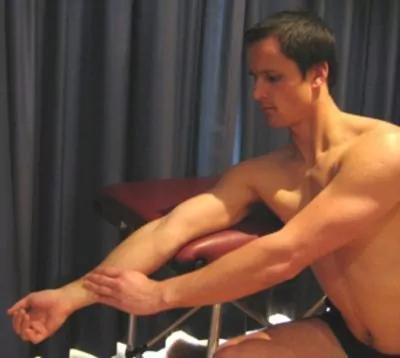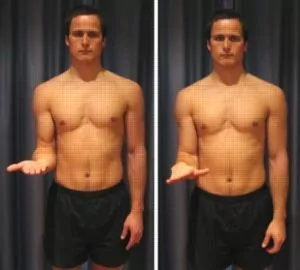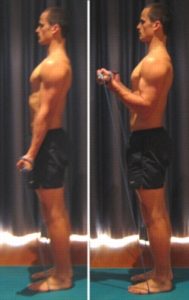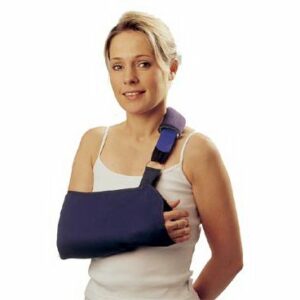Elbow Impingement
Updated:
(Also known as Posterior Impingement Syndrome, Posterior Impingement of the Elbow)
What is elbow impingement?
Elbow impingement is a condition characterized by compression and damage to soft tissue (such as cartilage) situated at the back of, or within the elbow joint.
The elbow joint primarily comprises of the articulation of two bones, the humerus (upper arm bone) and the ulna (inner forearm bone – figure 1). Shock absorbing cartilage lies between these joint surfaces cushioning the impact of one bone on another.

When the elbow is straightened fully (figure 2), soft tissue is compressed at the back of the joint. If these compressive forces are excessive or too repetitive and beyond what the joint can withstand, damage and inflammation of the cartilage and/or soft tissue at the back of the elbow joint may occur. This condition is known as elbow impingement. Occasionally, bony spurs may develop within the elbow joint contributing to the problem.

Causes of elbow impingement
Elbow impingement typically occurs due to activities that excessively or repetitively straighten the elbow (hyperextension – Figure 2) often in combination with a sideways (valgus) force. This may occur suddenly, due to a specific incident involving a hyperextension force, or, more commonly, due to repetitive strain associated with overuse (such as repetitive throwing).
In the throwing athlete, the “winding up” or “cocked” phase of the throwing motion (just prior to throwing) may hyperextend the elbow and place significant strain on the elbow joint. As a result, elbow impingement may occur due to overuse associated with repetitive throwing (especially in throwers who ‘open up too soon’ or throw with a low arm) and are particularly common in baseball pitchers, cricketers and javelin throwers. Elbow impingement may also occur in martial arts due to repetitive punching, forcing the elbow into hyperextension.
Occasionally, elbow impingement is seen in contact sports and may occur due to a collision to the back of the elbow (i.e. a hyperextension force – figure 2), forcing the elbow to bend in the wrong direction (such as another player falling across the back of the elbow).
Signs and symptoms of elbow impingement
Patients with this condition typically experience pain at the back of the elbow that increases with forced hyperextension of the elbow. Pain may also increase on firmly touching the affected area. In those patients whose injury occurs from overuse, symptoms usually develop gradually and progressively over a period of time.
In minor cases of elbow impingement (whether traumatic or due to overuse), patients may be able to continue activity only to experience an increase in pain, swelling and stiffness in the elbow after activity with rest (particularly first thing in the morning). As the condition progresses (particularly in the throwing athlete), pain may increase during activity and can eventually prevent activity performance. Patients may also experience a loss of elbow movement, in particular, an inability to fully straighten the elbow due to stiffness and pain.
Diagnosis of elbow impingement
A thorough subjective and objective examination from a physiotherapist is usually sufficient to diagnose elbow impingement. Investigations such as X-rays, ultrasound, CT scan or MRI may be indicated to assist with diagnosis and rule out other conditions.
Treatment for elbow impingement
Some patients with elbow impingement heal well with appropriate physiotherapy treatment. The success rate of treatment is largely dictated by patient compliance. A vital aspect of treatment is that the patient rests sufficiently from any activity that increases their pain (a brace or protective taping may be required).
Activities placing large amounts of stress on the elbow should also be minimized, particularly throwing or hyperextension activities. Resting from aggravating activities ensures the body can begin the healing process in the absence of further tissue damage. Once the patient can perform these activities pain free a gradual return to these activities is indicated provided there is no increase in symptoms.
Ignoring symptoms or adopting a ‘no pain, no gain’ attitude is likely to lead to the condition becoming chronic. Immediate, appropriate treatment in patients with elbow impingement is essential to ensure a speedy recovery. Once the condition is chronic, healing slows significantly resulting in markedly increased recovery times and an increased likelihood of a poor outcome.
Patients with elbow impingement should follow the R.I.C.E. Regime in the initial phase of injury. The R.I.C.E regime is beneficial in the first 72 hours following injury or when inflammatory signs are present (i.e. morning pain or pain with rest). The R.I.C.E. regime involves resting from aggravating activities (this may include the use of a brace or protective tape), regular icing, the use of a compression bandage and keeping the arm elevated. Anti-inflammatory medication may also significantly hasten the healing process by reducing the pain and swelling associated with inflammation.
Patients with this condition should perform pain-free flexibility and strengthening exercises as part of their rehabilitation to ensure an optimal outcome. The treating physiotherapist can advise which exercises are most appropriate for the patient and when they should be commenced.
A graduated return to activity or sport as guided by the treating physiotherapist is required in the final stages of treatment for this condition. Correction of throwing technique is particularly important in those cases where faulty throwing biomechanics have contributed to the development of the condition. Upon return to sport, the use of taping or a protective brace may also be required to reduce the likelihood of recurrence.
In those patients who do not respond adequately to physiotherapy treatment, corticosteroid injection or arthroscopic surgery may be indicated to treat or remove the structures causing the impingement.
Physiotherapy for elbow impingement
Physiotherapy is important to hasten the healing process and ensure an optimal outcome in all patients with this condition, regardless of whether their condition is managed conservatively or surgically. Treatment may comprise:
- soft tissue massage
- stretches
- joint mobilization
- electrotherapy (e.g. ultrasound)
- anti-inflammatory advice
- taping
- bracing
- ice or heat treatment
- exercises to improve flexibility and strength
- education
- activity modification advice
- sporting technique correction
- a graduated return to activity program
Other intervention for elbow impingement
Despite appropriate physiotherapy management, some patients with elbow impingement do not improve adequately. When this occurs, the treating physiotherapist or doctor can advise on the best course of management. This may include further investigation such as X-rays, Ultrasound, CT scan or MRI, pharmaceutical intervention, corticosteroid injection, or review by a specialist who can advise on any procedures that may be appropriate to improve the condition. Surgical intervention may be indicated for those patients who do not respond adequately to physiotherapy or who have prominent bony spurs.
Exercises for elbow impingement
The following exercises are commonly prescribed to patients with this condition. You should discuss the suitability of these exercises with your physiotherapist prior to beginning them. Generally, they should be performed 3 times daily and only provided they do not cause or increase symptoms.
Elbow Bend to Straighten
Bend and straighten your elbow as far as possible pain-free (figure 3). Repeat 10 times provided there is no increase in symptoms.

Forearm Rotation
Begin with your elbow at your side and bent to 90 degrees (figure 4). Turn your palm up and down as far as possible pain-free. Repeat 10 times provided there is no increase in symptoms.

Theraband Bicep Curl
Begin this strengthening exercise with a resistance band under your feet and around your hands as demonstrated (figure 5). Your back and elbows should be straight. Slowly bend your elbows against the resistance band tightening your biceps. Perform 10 – 30 repetitions provided there is no increase in symptoms.

Physiotherapy products for elbow impingement
Some of the most commonly recommended products by physiotherapists to hasten healing and speed recovery in patients with this condition include:
To purchase physiotherapy products for elbow impingement click on one of the above links or visit the PhysioAdvisor Shop.
Other Exercises
- View more Elbow Strengthening Exercises.
- View more Elbow Flexibility Exercises.
Find a Physio for elbow impingement
Find a physiotherapist in your local area to treat elbow impingement.

Link to this Page
If you would like to link to this article on your website, simply copy the code below and add it to your page:
<a href="https://physioadvisor.com.au/injuries/elbow-forearm/elbow-impingement”>Elbow Impingement – PhysioAdvisor.com</a><br/>PhysioAdvisor offers expert physiotherapy advice on elbow impingement including: signs and symptoms, causes, diagnosis, treatment, exercises, physiotherapy products and more...
Return to the top of Elbow Impingement.



